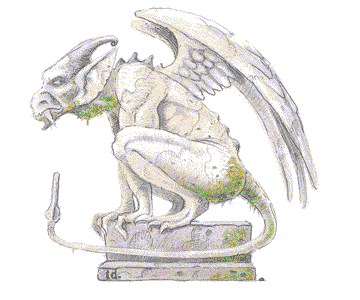Gargoyle

| Gargoyle | Margoyle | |
| Climate/Terrain: | Any land, subterranean, ocean | |
| Frequency: | Uncommon | Rare |
| Organization: | Tribe | Tribe |
| Activity Cycle: | Any | Any |
| Diet: | Carnivore | Carnivore |
| Intelligence: | Low (5-7) | Low (5-7) |
| Treasure: | M x 10 (C) | Q (C) |
| Alignment: | Chaotic evil | Chaotic evil |
| No. Appearing: | 2-16 | 2-8 |
| Armor Class: | 5 | 2 |
| Movement: | 9, Fl 15 (C) | 6, Fl 12 (C) |
| Hit Dice: | 4+4 | 6 |
| THAC0: | 15 | 15 |
| No. of Attacks: | 4 | 4 |
| Damage/Attack: | 1-3/1-3/1-6/1-4 | 1-6/1-6/2-8/2-8 |
| Special Attacks: | Nil | See below |
| Special Defenses: | +1 or better weapon to hit | +1 or better weapon to hit |
| Magic Resistance: | Nil | Nil |
| Size: | M (6' tall) | M (6' tall) |
| Morale: | Steady (11) | Elite (13) |
| XP Value: | 420 | 975 |
These monsters are ferocious predators of a magical nature, typically found amid ruins or dwelling in underground caverns. They have their own guttural language.
Combat: Gargoyles attack anything they detect, regardless of whether it is good or evil, 90% of the time. They love best to torture prey to death when it is helpless.
These winged creatures are excellent fighters with four attacks per round. Their claw/claw/bite/horn combination can inflict up to 16 points of damage, while their naturally tough hide protects them from victim's attacks.
Gargoyles favor two types of attack: surprise and swooping. Counting on their appearance as sculptures of some sort, gargoyles sit motionless around the rooftop of a building, waiting for prey to approach. Alternatively, a gargoyle may pose in a fountain, or a pair of the horrid beasts sit on either side of a doorway. When the victim is close enough, the gargoyles suddenly strike out, attempting only to injure the victim rather than to kill it all at once. (To a gargoyle, inflicting a slow, painful death is best.)
When on the move, gargoyles sometimes use a "swoop" attack, dropping down suddenly from the sky to make their attacks in an aerial ambush. In this case, they can make either two claw attacks or one horn attack. To make all four of their attacks, they must land.
Habitat/Society: Gargoyles live in small groups with others of their kind, interested in little more than finding other creatures to hurt. Smaller animals are scarcely worth the trouble to these hideous monsters, who prefer to attack humans or other intelligent creatures.
Gargoyles often collect treasure from human victims. Individuals usually have a handful of gold pieces among them, with the bulk of their treasure hidden carefully at their lair, usually buried or under a large stone.
Ecology: Originally, gargoyles were carved roof spouts, representing grotesque human and animal figures. They were designed in such a way that water flowing down gutters would be thrown away from the wall, so as to prevent stains and erosion. Later, some unknown mage used a powerful enchantment to bring these horrid sculptures to life. The race of gargoyles has flourished, spreading throughout the world.
Gargoyles do not need to eat or drink, so they can stand motionless for as long as they wish almost anywhere. The damage they do to other creatures is not for sustenance, but only for their distorted sense of pleasure.
Because they are fairly intelligent and evil, they will sometimes serve an evil master of some sort. In this case, the gargoyles usually act as guards or messengers; besides some gold or a few gems, their unsavory payment is the enjoyment they get from attacking unwanted visitors.
The horn of the gargoyle is the more common active ingredient for a potion of invulnerability and can also be used in a potion of flying.
Kapoacinth
This creature is a marine variety of gargoyle that uses its wings to swim as fast as the land-dwelling gargoyle flies. Kapoacinth conform in all respects to a normal gargoyle. They dwell in relatively shallow waters, lairing in undersea caves.
Like gargoyles, kapoacinth are eager to cause pain to others, and mermen, sea elves, and human visitors are all equally qualified candidates for this.
Margoyle
Margoyles are a more horrid form of gargoyle. They are found mainly in caves and caverns. Their skin is so like stone that they are only 20% likely to be seen when against it. They attack with two claws, a pair of horns, and a bite. They speak their own language and that of gargoyles. They are 20% likely to be found with the latter, either as leaders or masters.
| Previous Index Next | Cover Up |
Сайт создан в системе uCoz